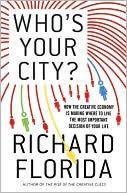A debate that periodically erupts in the comments sections of this blog centers on a perceived solution to traffic congestion on Interstate arteries, unaffordable housing and other ailments of large, dysfunctional metropolitan areas. Why don’t employers just move the jobs closer to where to where people live? In the words of blogger Ray Hyde, why don’t we just create more new places instead of cramming people into the old ones?
Good question. Indeed, it’s such a good question that Richard Florida devotes a full chapter to the topic in his new book, “Who’s Your City?” Florida posits the existence of a “clustering force” — a set of economic imperatives that drive businesses and people closer together. Despite the existence of cell phones, laptops, BlackBerries and Internet connectivity, which in theory should liberate people from the need to cluster, Florida contends that the Knowledge Economy puts a premium on physical proximity.
Florida frames the issue this way:
“If we postulate only the usual list of economic forces,” the Nobel Prize-winning economist Robert Lucas wrote in 1988, “cities should fly apart.” After all, Lucas reminds us, land “is always far cheaper outside the cities than inside.” Why, then, didn’t businesses and people move en masse out to where costs are substantially lower?
To answer that question, Lucas posed another: “What can people be paying Manhattan or downtown Chicago rents for, if not to be around other people?”
Economy 4.0: Clustering offers social and economic advantages that non-clustering does not. “The benefits in terms of innovation and productivity,” Florida writes, “far outweigh the higher costs of living and doing business there.” As faithful Bacon’s Rebellion readers know, Florida is employing the same vocabulary I use in my Economy 4.0 analysis (See “Peak Performance in a Flat World.”) The quest for innovation and productivity drive the Knowledge Economy just as the quest for low labor and raw material costs drove the industrial economy.
While the industrial economy required a limited amount of clustering — proximity to a sufficient supply of unskilled and semi-skilled labor, which could be found in any small town where excess labor was migrating off the farms — the Knowledge Economy is arising around industry clusters, in which people with highly knowledge, skill sets and relationships interact in a highly collaborative basis.
Florida concedes that clustering creates drawbacks and obstacles to growth: traffic congestion, rising crime rates and unaffordable housing. “Eventually,” he says, “they are likely to pose significant barriers to a city’s future development.” But somehow, super-congested places like San Jose, Calif., Manhattan and Boston keep forging ahead. They transcend those limitations, Florida suggests, because clustering creates so much wealth through innovation and productivity gain that the advantages outweigh the hassles. “Cities become wealthier and more creative the bigger they get.”
This is the force that Florida believes is driving metropolitan areas to fuse into mega-regions (which I discussed here). I’m not persuaded yet that the concept of “mega-regions” reflects any meaningful social or economic reality beyond an unbroken expanse of urban development of varying densities. But I do believe that Florida has identified one of the central economic forces shaping urban economies at work in the world today.


Leave a Reply
You must be logged in to post a comment.